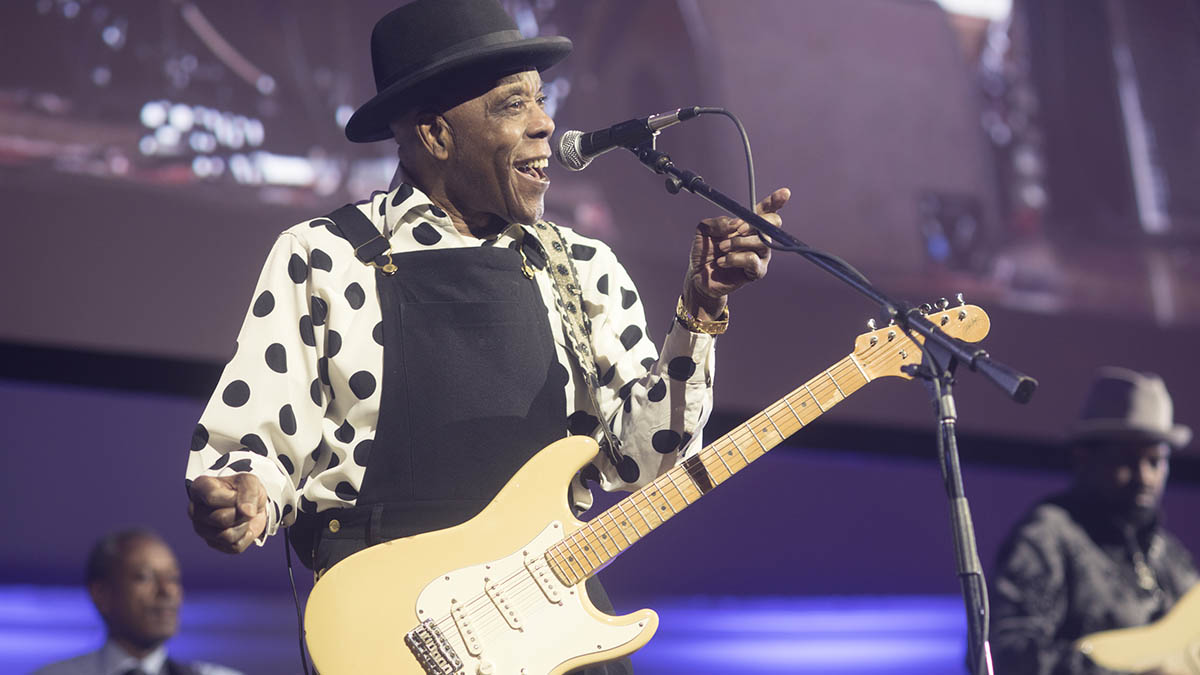Buddy Guy’s 5 greatest guitar songs
The electric blues pioneer, Chicago guitar great and world's greatest living bluesman's career in five key tracks

Still recording and performing at the age of 86, Buddy Guy has lived the archetypal blues story. His first job was picking cotton in Louisiana before he moved to Chicago at 21. He didn’t expect to become a star; he just wanted to live somewhere he could see the greats play.
After starving for several months, he lucked into jamming with Otis Rush at the 708 club, where Guy caused such a stir that the owner phoned Muddy Waters to come and watch.
With Waters’ patronage, Guy quickly landed a record deal, but his early recordings were watered down, without the distortion and feedback he used live. “I told [label boss] Leonard Chess we should get that sound on record,” he recalled later. “He just told me, ‘Ain’t nobody gonna buy that noise, man!’”
Jeff Beck and Eric Clapton did buy that noise, however, and a young Jimi Hendrix once cancelled a show to watch Buddy Guy instead. A spectacular showman, Buddy used his 150 foot cable to begin gigs outside the venue and leap into the crowd.
His new album The Blues Don’t Lie shows Buddy as the last and greatest of the electric blues pioneers. “I promised them all,” he remembers, “BB King, Muddy, Sonny Boy – as long as I’m alive, I’m going to keep the blues alive.”
1. Sit and Cry (The Blues) (1958)
Buddy arrived in Chicago with a Gibson Les Paul Goldtop. Two days before his first recording session, though, the guitar was stolen, changing the course of guitar history. A desperate Guy borrowed $160 from a club owner to buy a Stratocaster, which he used on this, his debut single.
The all-star band also included Willie Dixon on bass, second guitarist Otis Rush, and future Chuck Berry sideman Odie Payne on drums. Although the tone is cleaner and more controlled than Guy would have preferred, his lead style was already well developed. At 2:17 there’s a turnaround lick that Stevie Ray Vaughan clearly borrowed, and Guy’s approach undoubtedly informed Vaughan’s version of Texas Flood.
Get The Pick Newsletter
All the latest guitar news, interviews, lessons, reviews, deals and more, direct to your inbox!
The riffs to this song and Larry Davis’ original Texas Flood, released the same year, are similar but Vaughan’s lead fills sound more like Guy than Davis. Compared to the likes of B.B. King, Guy is noticeably busier. The licks between vocal lines have a tumbling quality, tripping over themselves with rhythmic variations.
“Didn’t mind jammin’ notes together in a way that wasn’t proper,” Buddy wrote later. “Notes crashing into each other was another way to get attention. I learned how to ride high on electricity.” The electricity was toned down for the studio, but the notes still crashed into each other.
2. Mary Had a Little Lamb (A Man and the Blues, 1968)
A reworking of a nursery rhyme is an unpromising premise for a blues classic, but Guy’s stonking riff and acrobatic vocals made it a triumph. The way his syncopated chord stabs bounce off the horns shows his time as a session musician at Chess Records had paid off.
There’s still no sign of the howling distortion he could conjure live, but his Strat sounds big, punchy and clear – there’s no sign of the weedy or shrill tones that lesser players can suffer from. A clean amp at that volume is an unforgiving beast, but Guy delivers his licks with authority.
Stevie Ray Vaughan covered this version faithfully on his debut album, even using the same opening lick on his solo. Vaughan, though, sticks to the minor pentatonic, while Guy ventures out into the major at points.
This album, A Man and the Blues, combined Guy’s blues styles with soul much as Albert King had done on Born Under a Bad Sign, and the insistent Motown drum pattern and horn arrangement make this a jubilant blues performance.
3. One Room Country Shack (Live in Montreux, 1978)
The live album with Junior Wells Live in Montreux (re-released in 1999 as Everything Gonna Be Alright) finds Guild-era Guy delivering humbucker-fueled madness. He throws the kitchen sink at this opening cut, showing that whatever can be said for B.B. King’s ‘less is more’ philosophy, more can also be more.
The licks cascade into each other like someone talking too excitedly to pause for breath, but there’s an art to the chaos. At the end of his intro solo, around 1:23, Guy plays a perfectly executed turnaround, a constant stream of notes that nevertheless beautifully highlight the changes underneath. You could listen to the isolated guitar line and still know exactly what chords he’s playing over just from the guitar melody.
Back in the ’60s, Guy had been among the first to spot to the potential of an overdriven amp. “When I heard the buzzin’ and the fuzz tones distorting the amps, that didn’t bother me none,” he wrote in his autobiography. “I figured fuzz tones and distortion added to the excitement of the sound.” Live recordings are the only place to hear the vintage Guy with a cooking amp, and here he balances it perfectly on the edge of clarity and sustain.
4. Damn Right, I’ve Got the Blues (Damn Right, I’ve Got The Blues, 1991)
While the guitarists he influenced became stars, Buddy spent the ’70s and ’80s in the wilderness, with no record deal in his home country and a relentless gigging schedule. After a performance with Eric Clapton at the Albert Hall, though, Guy was introduced to Silvertone Records boss Andrew Lauder.
Signing immediately, Lauder brought in Roxy Music’s John Porter to produce, and Guy was finally happy with the sound. “John worked hard to let me sound the way I sound live,” said Buddy in his autobiography. “What you hear is a man used to wearing handcuffs flying free as a bird.”
Guy’s Strat tone was dirty yet clear. Guy had pioneered lodging the 3-way switch on his 1958 Strat between positions to get combinations of pickups, and it’s those in-between sounds that predominate here. Damn Right became the biggest hit of Guy’s career, bolstered by guest appearances on the album from Jeff Beck, Eric Clapton and Mark Knopfler.
Still, on hearing Guy’s potential finally captured on tape it’s hard to ignore the missed opportunity. It’s a great blues album, but its impact is lessened because it came after Wheels of Fire, Are You Experienced and Texas Flood. It could and should have been made 30 years earlier, when it would have been truly revolutionary.
5. I Let My Guitar Do The Talking (The Blues Don’t Lie, 2022)
Released exactly 65 years since he first arrived in Chicago, 2022’s The Blues Don’t Lie arrives with Buddy receiving something like the recognition he deserves: multiple Grammy Awards, induction into the Rock & Roll Hall of Fame, and a queue of star collaborators.
But on this album opener, Guy takes care of business on his own. Hearing his wah-soaked Strat, it’s hard to avoid thinking of Hendrix, but as we’ve discussed, that comparison is back-to-front. The frenetic tremolo picking and scorching double-string bends show the octogenarian Guy hasn’t lost a step, and the scorching tone is among the best he’s ever recorded.
Elsewhere on the album, Jason Isbell, James Taylor, and Mavis Staples feature. In many ways, Guy’s 21st century resurgence is similar to the latter stages of Johnny Cash’s career: after decades in obscurity, a 1960s legend is revived through collaborations with new talent, all of whom were influenced by the original ’60s material. Where Cash’s voice grew hauntingly fragile with age, though, Guy’s guitar and voice have an intensity that show little sign of waning.
- The Blues Don't Lie is out now via RCA.
Jenna writes for Total Guitar and Guitar World, and is the former classic rock columnist for Guitar Techniques. She studied with Guthrie Govan at BIMM, and has taught guitar for 15 years. She's toured in 10 countries and played on a Top 10 album (in Sweden).










